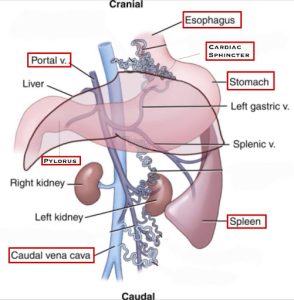124 Stomach in Knots? What Could Go Wrong?
veath003; eric4898; and stins091
Learning Objectives
- Understand what GDV is
- Learn the causes of GDV
- Know the clinical signs of GDV
- Understand the effects of GDV
Lesson
To start, lets review the anatomy of the stomach.

Food moves into the stomach from the esophagus via the opening of the cardiac sphincter. Food then moves through the various parts of the stomach (cardiac, fundus, body, and pylorus) and into the small intestines via the pyloric sphincter. The main portal vein has branches that come off it that go to both the spleen and the stomach. This gives blood flow to both the stomach and spleen. The caudal vena cava coming from the heart also runs right along the stomach. To the left side of the stomach, the spleen will be found.
Now what would happen if the stomach got twisted? In the veterinary world, we call that a GDV!
GDV is gastric dilatation and volvulus. Gastric dilatation is also known as bloat. Bloat occurs when there is gas, fluid, or ingesta build up into the walls of the stomach leading to extreme pressure within the stomach itself causing a distended or swollen look to an animal’s belly. They look as if they are bloated just like we sometimes do after eating a large meal. The extra pressure within the stomach leads to poor circulation of the stomach. With GDV, increased pressure will lead to the rotation or twisting of the entire stomach. You can think of it as the stomach is twisting and tying itself into a knot. The esophagus will twist as the pylorus part of the stomach moves upward. The pylorus ends up on the opposite side of the stomach trapping the air, fluid, or ingesta inside. This tying will cause constriction (or cutting off circulation) of the vessels to and around the stomach.
Watch this video below to see what happens:
The exact cause of GDV is not completely known. It is found to be associated with a large intake of food or water and potential increased stress of the animal. It is more common in large, deep-chested breeds of dogs.
Clinical signs of a GDV are:
- Belly pain/discomfort
- Drooling
- Act of retching without vomiting
- Bloated/distended appearance
- More severe signs: blue gums, tachycardia, weakness, systemic shock
But why does this matter and how does this impact an animal?
Within the GI tract the rotation and expansion of the stomach can cause many issues within the GI tract. One of the main complications that occurs is cell death and sloughing of the gastrointestinal tract, stomach and spleen. This is caused by a lack of blood flow due to the rotation and expansion of the stomach that puts pressure on the large arteries/veins within the area. As the stomach dies from a lack of blood flow, toxins are released into the blood and the shock worsens. The stomach can eventually rupture if swelling continues. In addition to cutting off blood flow to the GI organs, the swelling of the stomach increases pressure on the large veins/arteries housed within the abdomen (ie. aorta, vena cava, etc). This causes circulation to slow throughout the body leading to a state of septic shock and vital organ death due to the lack of blood and oxygen. The swelling of the stomach, along with the lack of blood flow can also cause the dog to collapse with respiratory issues and cardiac arrhythmias often present.
The best way to manage dogs at risk for GDV is through feed management, using the following feeding management tools as a guide:
- Feeding 2-3 smaller meals a day rather than one large meal
- Avoiding of feeding foods with oil as one of the first four ingredients
- Using a slow feeder bowl, puzzles, toys to help control the rate at which your dog eats the feed
- Avoiding of high exercise after a meal
Activity
Work through these cases to test out your new knowledge/

